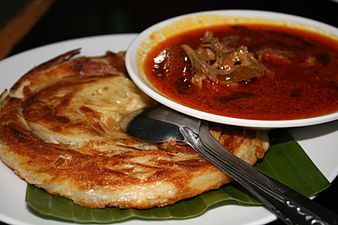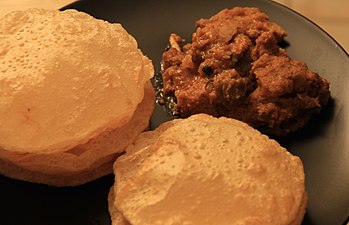 | |
| Alternative names | Kosha Mangso |
|---|---|
| Type | Curry |
| Course | Main course |
| Place of origin | India |
| Region or state | Indian subcontinent |
| Associated cuisine | India, Sri Lanka Bangladesh, Pakistan, Nepal, Guyana, Suriname, Trinidad and Tobago, Jamaica |
| Serving temperature | Hot |
| Main ingredients | Goat meat or mutton, tomato, onion, garlic, ginger, coriander leaves, Indian spices |
| Similar dishes | Goat curry |
| This article is part of the series on |
| Indian cuisine |
|---|
 |
Regional cuisines
|
| Ingredients, types of food |
| Preparation, cooking |
| See also |
| Related cuisines |
Mutton curry (also referred to as kosha mangsho, lamb curry, or goat curry) is a dish that is prepared from goat meat (or sometimes lamb meat) and vegetables. The dish is found in different variations across all states, countries and regions of the Indian subcontinent and the Caribbean.
Mutton curry was originally prepared putting all the ingredients together in a earthen pot and slow cooking the whole curry by wood fire on a clay oven. Today it is cooked using pressure cookers and slow cookers after briefly sautéing all the ingredients and spices in a big wok. The steadily cooked mutton becomes more tender than normally cooked mutton. Mutton curry is generally served with rice or with Indian breads, such as naan or parotta. The dish can also be served with ragi, a cereal.
Ingredients
Common ingredients used to prepare mutton curry include: mutton or goat meat, salt, turmeric powder, mustard oil, ginger garlic paste, dahi (yogurt), assortment of spices, onion, chilli, tomato, and coriander leaves.
Variations
Odisha
In Odisha, mutton curry is always made of khasi goat meat (meat of young castrated male goat). There are many varieties of goat meat curries prepared in Odisha. Simple and flavorful ingredients are used to prepare the curry and usually served with roti, naan or in Western Odisha, puffed rice (mudhi). Some of the popular curries are:
- Mutton Kashā (Odia: ମାଂସ କଷା, romanized: Māṅså Kåṣā)
- Mutton Curry (Odia: ମାଂସ ତରକାରୀ, romanized: Māṅså Tårkāri)
- Mutton Roasted in Bamboo or Bamboo Mutton (Odia: ବାଉଁଶ ପୋଡ଼ା ମାଂସ, romanized: Bãuśå Poṛā Māṅså)
- Mutton Roasted in Leaf (Odia: ପତ୍ର ପୋଡ଼ା ମାଂସ, romanized: Påtrå Poṛā Māṅså)
- Mutton in Clay Pot (Odia: ମାଟି ହାଣ୍ଡି ମାଂସ, romanized: Māṭi Hāṇḍi Māṅså)
- Mutton Besar (Odia: ମାଂସ ବେସର, romanized: Māṅså Besår)
While mutton curry is usually eaten with rice, in Western Odisha, Mangsa Kashā is particularly relished with mudhi (puffed rice). Mangsa Kashā is said to be the predecessor of the popular Bengali goat curry dish known as Kosha Mangsho most probably introduced by the Odia cooks who moved to West Bengal during the British rule to work in the kitchens of Bengali families.
Bihar
Mutton is typically cooked in Bihar in curried form. In addition to fish and chicken, mutton is common in Bihari cuisine. Mutton curry is traditionally served with Malpua on Holi, while it is eaten with rice in a routine everyday meal. In Champaran, mutton is cooked in a sealed earthen pot as a one-pot curry.
Gujarat
Mutton curry has a special place in Surati cuisine. A rich mutton dish known as Tapelu which finds its origins in the kitchens of the Surati Khatri community, is often cooked in large batches, especially during festivities. Goat offal also finds a place in the cuisine of Surat.
West Bengal
Kosha mangsho is the Bengali version of mutton curry. It traditionally has less juice and more gravy than mutton curries eaten in other parts of India. This dish is prepared in a kosha style, which involves retaining the mutton's flavor and moisture using slow cooking and sautéeing methods.
Kosha mangsho is traditionally prepared as part of the celebration of Kali Puja, a festival dedicated to the Hindu goddess Kali, celebrated on the New Moon day of the Hindu month Kartik.
Railway mutton curry is a British Raj colonial-era dish that was served on long-distance trains. The dish was served with dinner rolls. Tamarind was originally used to extend its shelf life. Some restaurants serve the dish in present-day times, such as Oh! Calcutta! restaurant in Kolkata, India. Railway mutton curry is prepared using a coconut milk base.
- Mutton curry variations
-
A pot of lamb curry
-
 Roti cane with mutton curry (top)
Roti cane with mutton curry (top)
-
 Bamboo mutton
Bamboo mutton
-
 Bengali mutton curry
Bengali mutton curry
-
 Mutton Kosha
Mutton Kosha
-
 Luchi Maangsho
Luchi Maangsho
-
 Mutton Chaap
Mutton Chaap
-
 Mutton Keema Kabab
Mutton Keema Kabab
-
 Rogan josh
Rogan josh
-
 Mutton Pulao
Mutton Pulao
Maharashtra
Black Mutton curry (also referred to as konkani black mutton) is a dish that is prepared from goat or lamb meat, charred coconuts, and a signature spice blend. The regional dish originated in the Konkani district of Maharashtra, India.
Black Mutton curry was originally made by preparing a black spice paste consisting of charred coconuts, onions and peppers with spices which was then cooked low and slow in a cast iron wok. The cooked paste was added with the mutton along with fresh herbs and spices in an earthen pot and cooked low and slow till tender. The curry is typically served with breads such as Bhakari, Chapati, Pav or rice.
The dish utilizes a unique blend of spices called the Maharashtrian garam masala, which consists of cardamom, nutmeg, khus khus (poppy seeds), saunth (dried ginger), and many other Mughlai spices which lend the black mouton an intoxicating flavor and a robust color.
Counterfeit variations
In 2012, in the Midlands, England, trading standards officers working undercover went to twenty restaurants that were randomly chosen and bought 39 lamb curry and kebab dishes. Four of the dishes contained no lamb, instead using a mixture that contained beef, pork or chicken. In the investigation, it was found that only three lamb curries out of the nineteen tested contained only lamb. Most were found to consist of a mixture of lamb with beef or chicken. Additionally, all of the twenty lamb kebabs that were sampled contained meats in addition to lamb that was mixed with it, such as beef, pork or chicken.
See also
References
- Mazumdar, Arunima (11 April 2015). "Bengali recipe: Kosha Mangsho". The Times of India. Retrieved 10 May 2015.
- "Rick Stein's perfect Indian recipes". NewsComAu. 10 May 2015. Retrieved 10 May 2015.
- Cooking time Prep: 25 mins Cook: 3 hrs. "Goat curry". BBC Good Food. Retrieved 5 September 2015.
{{cite web}}: CS1 maint: numeric names: authors list (link) - "Goat (Mutton) Curry Recipe". Indianfood.about.com. Retrieved 5 September 2015.
- Smith, Charmian (23 March 2011). "Video: How to make Indian-style mutton curry". Otago Daily Times. Retrieved 8 May 2015.
- ^ Sen, Rajyasree (29 September 2014). "Mutton Curry and Coconut Prawn Recipes for the Durga Pujo Festival". The Wall Street Journal. Retrieved 8 May 2015.
- Ray, Bikramjit (13 February 2015). "Mutton of the matter". The Hindu Business Line. Retrieved 8 May 2015.
- Krishna, Geetanjali (25 March 2011). "Geetanjali Krishna: Ragi makes a comeback". Sify. Archived from the original on September 10, 2015. Retrieved 10 May 2015.
- Pansari, Group (April 20, 2021). "Mutton Curry Recipe". Pansari Group. Retrieved February 10, 2022.
{{cite web}}:|first=has generic name (help) - Das, Soumitra (29 April 2015). "Recipe: Mutton curry in mustard oil". Times of India. Retrieved 8 May 2015.
- "Mangsha Besara". December 4, 2017.
- "Is Odisha India's most underrated food destination?". Condé Nast Traveller India. December 15, 2017.
- Sinha, Namya (24 March 2024). "Holi Special Mutton Curry: The Champion Celebratory dish in Bihar". Retrieved 16 June 2024.
- "Champaran Meat". Bihar Tourism. Retrieved 16 June 2024.
- ^ Ramnane, Khushboo (3 December 2019). "In Surat, meat-eating communities challenge Gujarat's 'vegetarian' label with heirloom recipes". Firstpost. Retrieved 16 June 2024.
- "Gujarat HC's strictures against the campaign to stop sale of non-vegetarian food is a much-needed pushback". The Indian Express. 11 December 2021. Retrieved 16 June 2024.
- Sanghvi, Vir (29 June 2014). "India's greatest mutton curry". Hindustan Times. Archived from the original on January 21, 2015. Retrieved 8 May 2015.
- "Delectable Bengali foods to tuck into on Poila Boishakh". The Times of India. 15 April 2015. Retrieved 10 May 2015.
- "Kosha mangsho and Bhoot Chaturdashi: Celebrating Kali Puja and Diwali, Bengali style". Firstpost. 22 October 2014. Retrieved 10 May 2015.
- ^ Chatterjee, A. (2013). Oh! Calcutta: Cookbook. Random House India. ISBN 978-81-8400-456-4. Retrieved 10 May 2015.
- Time Out India: Perfect Places to Stay, Eat and Explore. Perfect Places Series. Time Out Guides. 2010. p. 81. ISBN 978-1-84670-164-1. Retrieved 10 May 2015.
- Fodor's Essential India: with Delhi, Rajasthan, Mumbai & Kerala. Full-color Travel Guide. Fodor's Travel Publications. 2015. p. 785. ISBN 978-1-101-87868-2.
- Bhandari, R. (2013). The Raj on the Move. Roli Books Pvt. Ltd. ISBN 978-93-5194-037-1.
- ^ Brien, C.O. (2013). The Penguin Food Guide to India. Penguin Books Limited. p. 175. ISBN 978-93-5118-575-8.
- "Konkan", Misplaced Pages, 2022-04-05, retrieved 2022-04-05
- "This Konkani Mutton Curry Is Pure Black In Colour, But Why?". Slurrp. Retrieved 2022-04-05.
- ^ Food (30 April 2012). "Lamb curry contains no lamb, trading standards warn". Telegraph.co.uk. Retrieved 10 May 2015.
External links
- "From Railway Mutton curry to Bedmi-aloo: When railway food was an affair to remember". The Indian Express.